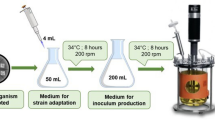Abstract
One of the most widely used feedstocks for potable or biofuel ethanol fermentation is blackstrap molasses, a byproduct of cane sugar production. Inconsistent quality of molasses frequently found in industrial production, however, makes ethanol production much less efficient and cost-ineffective. Besides fermentable sugars (sucrose, glucose and fructose) present in molasses, calcium is also found in the range of 10–20% of the total carbonated ash (15% by weight). In the sugar process, calcium is usually applied as lime, CaO, during defecation, which sometimes results in over-liming if juice quality is poor. In this study, the role of calcium residues (0–0.72% w/v of Ca2+ in the form of calcium chloride) on fermentation efficiency of yeast was evaluated using model solutions of sucrose, glucose and fructose (20% w/v). The results suggest a detrimental effect of calcium ions on yeast performance which was concentration dependent. A slight decrease in fermentation rates and ethanol yields was evident when calcium was present at 0.18% w/v Ca2+ in all sugar solutions. This effect was more pronounced when calcium ion concentration increased. At 0.72% w/v of Ca2+, the rates of fermentation and ethanol yields of all sugars were considerably decreased (the ethanol yields decreased by 14–25% relative to the control sample, i.e. no calcium ion added). At a very high concentration of Ca2+ (2.16% w/v), yeast fermentation of sucrose was almost absolutely inhibited. This might be, in part, due to the inhibition effect of invertase enzyme for conversion of sucrose to invert sugars, a limiting step in ethanol fermentation of sucrose by yeast. The pretreatment of molasses by acid prior to fermentation was then introduced to remove calcium which improved the fermentation efficiency.
Similar content being viewed by others
References
Anonymous (1994). Methods Book (1994) with First Supplement (1998). International Commission for Uniform Methods of Sugar Analysis. ICUMSA, Norwich, England.
Anonymous (2000). Official methods of analysis of AOAC (Association of Official Analytical Chemists) International (17th ed.). AOAC International, Gaithersburg, MD.
Chen JCP, Chou C (1993). Cane Sugar Handbook. 12th edition. John Wiley & Sons, Inc. New York, USA. pp. 399–431.
Higginbotham JD, McCarthy J (1998). Quality and storage of molasses. In:Sugar Technology: Beet and Cane Manufacture. In: P.W. van der Poel, H. Schiweck, T. Schwartz (eds), Druckhaus am Treptower Park, Berlin, Germany. pp. 973–992.
Oderinde RA, Ngoka LC, Adesogan EK (1986). Comparative study on the effect of the ferrocyanide and EDTA on the production of ethyl alcohol from molasses by Saccharomyces cerevisiae. Biotechnol Bioeng 28: 1462–1465.
Somogyi M (1952). Notes on sugar determination. J. Biol. Chem 195:19–23.
Takeshige K, Ouchi K (1995). Factors affecting the ethanol productivity of yeast in molasses. J. Ferment. Bioeng 75(5): 449–452.
Author information
Authors and Affiliations
Corresponding author
Rights and permissions
About this article
Cite this article
Chotineeranat, S., Wansuksri, R., Piyachomkwan, K. et al. Effect of calcium ions on ethanol production from molasses by Saccharomyces cerevisiae . Sugar Tech 12, 120–124 (2010). https://doi.org/10.1007/s12355-010-0024-6
Received:
Accepted:
Published:
Issue Date:
DOI: https://doi.org/10.1007/s12355-010-0024-6




